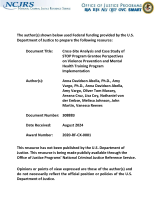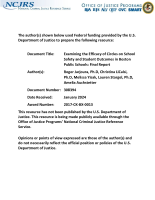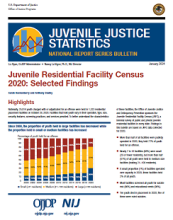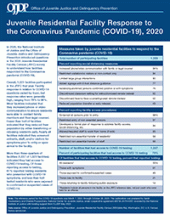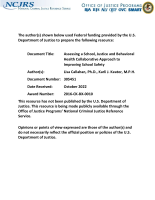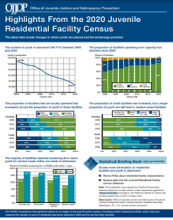Juvenile correctional facilities
Identifying COVID-19 Policies and Practice that Juvenile Justice Systems Should Maintain Long-Term: Listening Session 6: Juvenile Court Judges
Identifying COVID-19 Policies and Practice that Juvenile Justice Systems Should Maintain Long-Term: Listening Session 3: State Juvenile Justice Agency Administrators
Identifying COVID-19 Policies and Practice that Juvenile Justice Systems Should Maintain Long-Term: Listening Session 2: Juvenile Justice Defenders
Identifying COVID-19 Policies and Practice that Juvenile Justice Systems Should Maintain Long-Term: Listening Session 1: Juvenile Justice Crime Analysts
Examining the Efficacy of Circles on School Safety and Student Outcomes in Boston Public Schools: Final Report
The Distinction Between Transient and Substantive Student Threats
Juvenile Residential Facility Census, 2020: Selected Findings
Understanding the Quality and Perceived Impacts of SRO Training: An Evaluation of the Largest National Training Provider for School Police
Juvenile Residential Facility Response to the Coronavirus Pandemic (COVID-19), 2020
Training School Resource Officers to Improve School Climate and Student Safety Outcomes
Assessing a School Justice and Behavioral Health Collaborative Approach to Improving School Safety
Highlights From the 2020 Juvenile Residential Facility Census
Prevalence Estimation of Co-occurring Mental Health and Substance Use Disorders in Juvenile Facilities
Assessing the impact of treatment quality, matching and dosage on juvenile justice outcomes among a statewide sample of youth with co-occurring substance abuse and mental health disorders
Training for School Personnel to Prevent, Prepare, and Respond to School Safety Incidents
Developing Knowledge about What Works for Make Schools Safe: Implementation and Evaluation of Tools for Life in Jackson Public School District in Mississippi
Learning from Doing Evaluating the Effectiveness of the Second Chance Act Grant Program
Reauthorized in 2018, the Second Chance Act (SCA) aims to reduce recidivism and improve outcomes for people returning from state and federal prisons, local jails, and juvenile facilities through the provision of federal grants. During this panel, National Institute of Justice-funded researchers will detail two ongoing evaluations of the SCA grant program:
- An evaluation of the effectiveness of the SCA grant program per Title V of the First Step Act.
- A longitudinal examination of the long-term impacts of the SCA program.
See the YouTube Terms of Service and Google Privacy Policy
A Randomized Impact Evaluation of Capturing Kids’ Hearts
The Hidden Costs of Reentry: Understanding the Barriers to Removing a Criminal Record
NIJ hosted a webinar to discuss under-researched aspects of reentry: expungement of criminal records and the impact of those records. This webinar includes a presentation of ongoing research projects examining the impact of legal aid for expungement and past research projects studying the accuracy and permanency of criminal records and the prevalence of collateral consequences of conviction. A Q&A session will conclude this webinar.
See the YouTube Terms of Service and Google Privacy Policy


